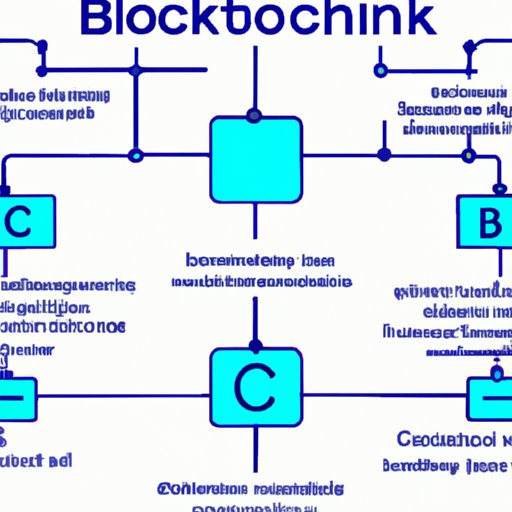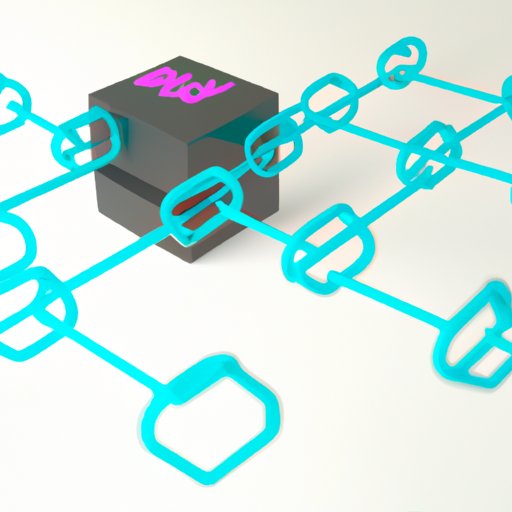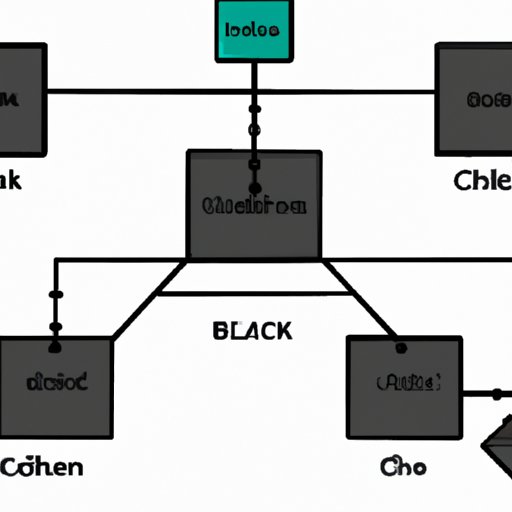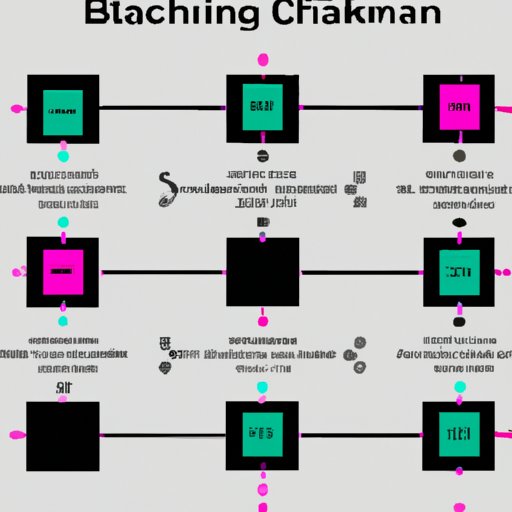Introduction
Blockchain technology has been gaining traction in recent years as an innovative way to securely store data and facilitate transactions. But what does a blockchain look like? This article will provide an in-depth exploration of blockchain technology, from its definition and key concepts to its visual representation and anatomy.

A Guide to Understanding Blockchain Technology
Before exploring the visuals of a blockchain, it’s important to understand the basics of this technology. Blockchain is a decentralized, distributed ledger that records digital transactions across multiple computers. It is secure by design, and the data stored on it is immutable, meaning that it cannot be changed or altered. Transactions are verified by a network of nodes, which are connected to each other via a peer-to-peer network.
The main benefit of using blockchain technology is that it eliminates the need for a third party or intermediary to facilitate transactions. This means that transactions can be completed quickly, securely, and cost-effectively. Additionally, blockchain technology offers transparency, as all transactions are recorded on the distributed ledger and visible to all participants in the network.
However, there are also some drawbacks of using blockchain technology. For example, it requires a significant amount of computing power and energy, and the cost of setting up and maintaining a blockchain network can be high. Additionally, security breaches can occur if the system is not properly maintained and updated.

Exploring the Visual Representation of a Blockchain
Now that we’ve explored the basics of blockchain technology, let’s take a look at how it is visualized. There are several different ways to represent a blockchain, ranging from simple diagrams to more complex visualizations. These visuals can be used to illustrate the structure of a blockchain, as well as the various components and processes involved.
One of the most common types of visuals used to represent a blockchain is a chart or diagram. These diagrams typically show the blocks in a blockchain, as well as the links between them. They can also include symbols and icons to represent different types of transactions and processes. Additionally, charts and diagrams can be used to demonstrate the flow of information within a blockchain, as well as how data is stored and secured.
Other types of visuals used to represent a blockchain include graphs, tables, and even 3D models. These visuals can help to illustrate the complexity of a blockchain, as well as the various components that make up the system. Additionally, they can be used to demonstrate how transactions are processed, stored, and secured.
What is a Blockchain and How Does it Work?
At a high level, a blockchain is a type of distributed ledger technology (DLT) that stores and verifies digital transactions across a network of computers. The structure of a blockchain consists of blocks, which are linked together in a linear chain. Each block contains a set of transactions, and these blocks are cryptographically linked to each other using hashes. The data stored on a blockchain is immutable, meaning that it cannot be changed or altered once it has been added to the chain.
The way in which transactions are stored and secured on a blockchain is based on consensus protocols. These protocols are used to ensure that all participants in the network have a copy of the same transaction history and that the data stored on the blockchain is accurate and up-to-date. Additionally, consensus protocols are used to prevent double spending, which is when a user attempts to spend the same cryptocurrency multiple times.
A Layman’s Guide to the Anatomy of a Blockchain
In order to better understand what a blockchain looks like, it’s important to understand the anatomy of this technology. A blockchain is composed of several components, including nodes, miners, and wallets. Nodes are computers that are connected to the network and are responsible for validating and relaying transactions. Miners are responsible for verifying and adding new blocks to the chain, while wallets are used to store and transfer cryptocurrencies.
Additionally, a blockchain utilizes cryptographic elements such as public and private keys, digital signatures, and hashing algorithms. Public and private keys are used to encrypt and decrypt data, while digital signatures are used to verify the authenticity of a transaction. Finally, hashing algorithms are used to generate unique identifiers for each block in the chain.
The Building Blocks of a Blockchain: A Closer Look
Cryptography is an essential element of blockchain technology. Cryptographic elements such as public and private keys, digital signatures, and hashing algorithms are used to secure data and facilitate transactions. Public and private keys are used to encrypt and decrypt data, while digital signatures are used to verify the authenticity of a transaction. Hashing algorithms are used to generate unique identifiers for each block in the chain.
Hashing algorithms are used to convert data into a fixed length string of characters, known as a hash. This hash is then used to link blocks together in a blockchain. Additionally, hashing algorithms are used to secure data stored on a blockchain, as any change to the data will result in a different hash value.

Visualizing the Structure of a Blockchain
In addition to diagrams and charts, there are several other types of visuals that can be used to illustrate the structure of a blockchain. For example, 3D models can be used to show the relationships between blocks, as well as how data is stored and secured. Additionally, graphs can be used to demonstrate the flow of information within a blockchain, as well as how transactions are processed.
When creating visuals to represent a blockchain, it’s important to use common symbols and icons. These symbols and icons are used to represent different types of transactions and processes, such as mining, verification, and storage. Additionally, they can be used to illustrate the various components of a blockchain, such as nodes, miners, and wallets.
An Illustrated Guide to Blockchain Technology
Blockchain technology can be used to create a wide variety of applications, ranging from digital currencies to smart contracts. Different types of blockchains can be used to achieve different goals, depending on the needs of the application. For example, public blockchains are used for open, permissionless systems, while private blockchains are used for closed, permissioned networks.
There are many real-world applications of blockchain technology, from banking and finance to healthcare and supply chain management. In the banking and finance sector, blockchain technology is being used to facilitate payments and reduce fraud. In the healthcare sector, it is being used to securely store patient data and medical records. Additionally, blockchain technology is being used in the supply chain industry to track products and ensure product quality.
Conclusion
Blockchain technology is an innovative way to store and secure data, as well as facilitate transactions. By understanding the basics of blockchain technology and exploring its visual representations, it’s possible to gain insight into the structure and components of this technology. Additionally, there are many real-world applications of blockchain technology, from banking and finance to healthcare and supply chain management.
If you’re interested in learning more about blockchain technology, there are many resources available online. You can find tutorials and courses to help you get started, as well as forums and communities where you can connect with other blockchain enthusiasts. Additionally, there are many events and conferences around the world where you can learn more about this technology.
(Note: Is this article not meeting your expectations? Do you have knowledge or insights to share? Unlock new opportunities and expand your reach by joining our authors team. Click Registration to join us and share your expertise with our readers.)
